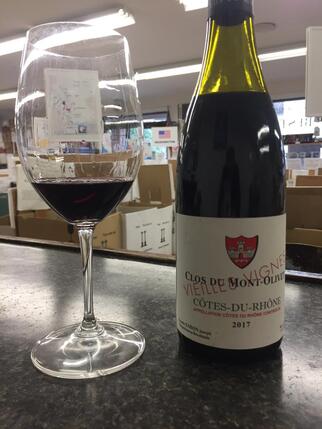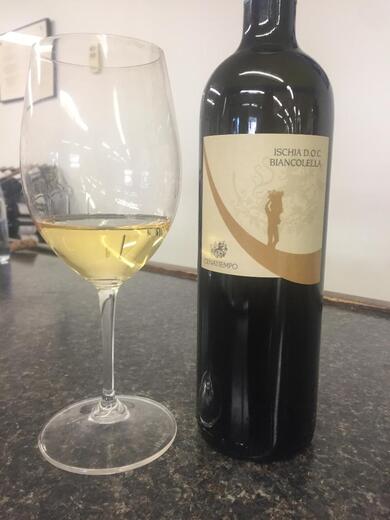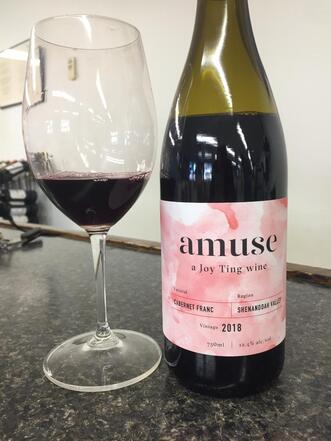 The appellation system for wines is NOT a guarantee of quality, only that the minimum standards for that designation have been met and the POTENTIAL is there for quality. A wine can underachieve from a mediocre winery even with potentially great fruit to work with, and just as likely a great wine can come from meager origins at the hands of a top quality winery. To parallel food, a poorly cooked piece of filet mignon can be very ordinary (we've all cooked those once or twice at home, I'm sure), but a master chef can make a burger you dream about for weeks. So when there is a 'basic' Cotes du Rhone like this, priced a little higher than usual, you have to look a little closer to see what sets it apart. You will find this is a wine that not only justifies its price point but will even strike you as a relative bargain. Considered a 'beacon of traditionalism' by their importer and most in the industry, this is one of the older independent wineries in the region, and have not changed their style just to follow the fashion of trends, with all their vines a minimum of 40 years old used in this bottling. This bottling is made with little time in oak for a more approachable character and is the most ready to drink wine they produce, but still possesses impressive classic character that many wines in the $20+ range from more 'tenderloin' areas of the Rhone can't even touch. Built from mostly Grenache, the small doses of Carignan and Syrah definitely make their presence known in giving the wine its rustic tones. From the first pour, there is a noticeable savory edge to the dark red fruit on the nose, equal provincial herbs and lightly smoked meat to the raspberry and black cherry tones, though the fruits start to catch up as it opens up. On the palate the texture is plenty mouthfilling, not missing the use of new oak one bit as it fills the mouth with fine tannins and savory natural flavors. Where some more modern Rhones would get into the more juicy red fruit tones, this stays robust with fine cocoa powder type tannins and only sweetening up a little bit as it opens up, the fruit mostly keeping the dried skin tones. Fans of older style Chateauneuf-du-Pape will definitely find this much more to their liking than many things out on the market now, and if you have never had the chance to taste something that was old school Rhone this is about as textbook as you will find. A perfect match with any savory, hearty and meaty dish you can imagine.
0 Comments
 We strive to keep the wines we use in the Insider's Picks as varied as possible from week to week, in order to reflect the diversity we represent in the store. We avoid using the same wine twice in the same vintage just because we always have so many things to choose from. Some wines we just can't stay away from as they are so consistent vintage after vintage, so as soon as they change over to a new year they are right back into rotation. The wines of Zorzal are just such wines. Not only are they great values, but they represent a different mindset for winemaking than what consumers usually come across from Argentina. All too often Malbecs from here get characterized by their 'size' and 'intensity', which leads to thicker, heavier, more extracted wines and often a lot of oak aging. Nothing wrong with those types of wines, to be sure (have plenty here we enjoy like that), but it's very limiting to the expression of the grape and the winemaker it that's all you're ever expected to make. Zorzal is part of an importer's stable of wines that looks to break those trends, carrying a large selection of natural Chilean/Argentine wines, a movement that's growing in both participation and quality across South America. To us, this is the ideal introduction into tasting and learning about natural wines as it introduces enough of the principles and flavor characters that mark the concept but doesn't slam you over the head with them. There's plenty of flavors and aromas familiar to all Malbec drinkers here that everyone will recognize, such as deep black fruits that gain a touch of richness and sweetness as it opens up. But the sweeter tones are more subtle and secondary, not the first and last thing you notice about it. There's no vanilla tones from oak, but it's not missed at all, with a mineral tone that makes the black fruits brighter and even a touch of citrus born from the use of natural yeasts during fermentation (a major component to the natural wine movement). On the palate the fruit is full bodied with plenty of intensity, but the black tones are more strongly pierced with tart berry skins, even a bit of orange and citrus peel, finishing with an almost zesty dry minerality. A wine that can handle big food with big flavors, but isn't overly 'big' in and of itself, able to play well with salty or vinegar-influenced meats as well.  This is a break from our usual norms this time of year, breaking out a white wine for the Insider's Pick in Winter. But with so many warm days recently, who can really tell, so seasonality can go right out the window. Plus a really fascinating wine like this is never confined to any one season. This come to us from a slowly growing stable of wines from one of the few producers on the island of Ischia, just off the coast of Naples. This island is part of the same volcanic chain as Mount Vesuvius on the mainland, and while its eruptions were not as catastrophic as its neighbor, it does have reference in both Greek and Roman mythology and was active as recently as the 14th century. Nowadays it is more known as a tourist attraction for their beaches and thermal fed hot springs, but the island is also the surprising home to a number of wine grape varieties that rarely get planted elsewhere. The intense character the volcanic soils brings to these grapes make them stand out in ways that just can't be found on the more mixed soils of the mainland, and with less than 20 square miles to work with there just isn't room to plant anything else. Along with Forastera, Biancolella is the grape of most importance here, usually making up the lion's share of local blends or being featured solo like it is here, and one that does make an occasional important appearance on the mainland For fans of Neapolitan or Campania region wines, you may first draw some comparisons of this to the Greco grape in that is has a tropical, almost floral nose with lots of juicy Mediterranean fruit and white citrus. The volcanic soils help to insert some pinpricks of minerality into the aromas, somewhat minty in the background that keep it lively and inviting. On the palate the texture is equally juicy and the flavors mirror the aromas, but the nervy minty minerality comes through even more, bringing out a very fresh and quenching mouthfeel where other wines can be more cloying, and finishes with a touch of fuzzy peach skin dryness. This is perfect to pair with fish or seafood dishes that have a lot of citrus and herb influence.  One of the most exciting aspects of the Virginia wine scene is that, being in its infancy relative to the rest of the world, we are still finding our way towards what our best 'style' really is. Places in France, Italy, and Spain have had literally centuries of trial and error behind them before evolving into a common tradition among producers in a region. Ideas and theories can take decades to fully be tested, so truly effective changes tend to happen slowly, often slower than the general public has patience for. Most of the time wineries need to play it relatively safe to produce wines that will sell well with the general public, so the experiments that help to evolve and move forward tend to happen in small batches and usually as 'side projects'. For several years our favorite example has been the 'R' wines from Riaan Roussow, the winemaker at Lovingston, and recently there has been the Lightwell Survey wines from Ben Jordan &Co. at Early Mountain. Now we can add the wines of Joy Ting to that list. After working at the Michael Shaps Wineworks for several vintages, Joy was hired to be the 'Research Enologist and Exchange Coordinator' for the Virginia Winemakers Research Exchange. Basically, her job is to help winemakers across the state with their processes and help them experiment to find the best ways to make wines where they are. When she gets the chance, her own label looks to take those ideas even further, and we couldn't be more excited to have this Cabernet Franc-as well as a Merlot and Chardonnay-to show off her work. Built with 50% whole cluster inclusion in the tank and partial carbonic maceration, this wine is built to get maximum flavor and color out of the tricky 2018 vintage without getting any harsh edges. A beautiful ruby dark color in the glass, the aromas jump from the glass after a few swirls, full of cranberry, cherry skins, fresh berries and hints of cracked pepper. After some time open there are hints of sweeter fruits like strawberry and cherry notes, but as a whole the aromas stay on the earthy/savory side. The palate is lithe and elegant with lots of the tart cranberry fruit punching through.The whole clusters and partial carbonic maceration gives the tannins a very fine, unobtrusive texture that only peeks in on the finish, as well as the bright acidity from the Shenandoah Valley sourced fruit that gives the finish This is a style of Cabernet Franc that pays more homage to the Loire than Bordeaux, fresh and savory, pretty and approachable enough to enjoy now or in the relatively short term before all the crunchy fruit fades away. |
The Best of the Best.We offering free tastings on these wines in the store every Thursday and Friday, and a 10% discount off the retail price through the duration of the day. Come on by and give them a try! Archives
July 2024
Categories |
Location |
|

 RSS Feed
RSS Feed